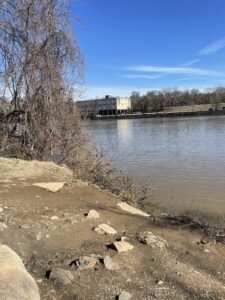This semester, our discussions about environmental activism and leadership made me think about what comprises successful environmental leadership. Key discussions for me included (a) how compromise happens between a variety of stakeholders (e.g., to determine the management of parks and green spaces), (b) how environmental activism can result in greater protections for natural spaces, and (c) the importance of educating people about environmental issues. Drawing from these discussions, I believe that crucial aspects of environmental leadership are the abilities to compromise while ensuring environmental priorities are met, to act and secure decisive wins for environmental causes, and to educate the public about the importance of addressing environmental issues in proactive and preventative ways before they create irrevocable harm.
First, successful environmental leadership involves the ability to understand viewpoints and compromise across a wide range of stakeholders (e.g., city planners, environmental activists, people who want historical sites preserved, and representatives of the tourism industry). However, it is important for leaders to hold firm on critical arguments in ways that lead to resolutions which may include concessions but also preserve core environmental interests. The complexities of reaching mutually agreed upon arrangements among stakeholders was illustrated by our class exercise to create a hypothetical battlefield park when opinions varied on how it would best be used. The city planner wanted to develop residential property and shopping areas, the Civil War historian wanted the site preserved exactly as it was, and the environmental activist wanted the site to be reclaimed by nature. An example of how a favorable resolution could be secured includes: (a) allowing residential development on a small part of the property with specific tree canopy requirements (e.g., 10% to 20% of residential property has to be covered by trees), and (b) restoration of the battlefield through constructive conservation that preserves its historical significance while allowing for green spaces. This kind of compromise, which advances environmental interests while meeting the needs of other stakeholders’ is a critical part of environmental leadership.
Figure 1: Totopotomoy Creek National Battlefield Park represents an area that could be utilized in a variety of manners for a variety of interests while maintaining environmental integrity
Second, environmental leadership includes the ability to generate decisive wins locally and for the broader environmental cause through direct activism. An illustrative example is the work of Newton Ancarrow to end rampant pollution of the James River in the mid-to-late twentieth century. Ancarrow and his fellow activists worked tirelessly in lobbying Virginia politicians, raising awareness of high pollution levels in the James River, and working against corporate interests who polluted the river. Several key wins, aided by the work of Ancarrow and the highly publicized Kepone crisis, culminated in the passage of the 1972 Clean Water Act. The Clean Water Act then paved the way for the recovery of the James River and other Virginia waterways. For example, the James River moved from a rating of an F to a B for water quality as a result of subsequent legislative and political wins secured on its behalf. Overall, the ability to serve as a catalyst for positive environmental change through activism is another characteristic of environmental leaders.
Figure 2: Ancarrow’s Landing, named for Newton Ancarrow, along the healthier James River
Lastly, successful environmental leadership includes the ability to educate the public on environmental issues in ways that promote action to successfully address them. At a fundamental level, it is not possible to accomplish leadership objectives (i.e., find compromises that protect environmental interests and generate decisive wins for the environmental cause) if the broader public does not understand the nature of the problems and care about finding solutions for them. For instance, prior to Newton Ancarrow’s activism and the Kepone crisis, many citizens simply ignored the health of the James River or turned a blind eye to the pollution, rather than pushing for its cleanup and water quality improvement. While activism undoubtedly played a large role in the river’s recovery, public education on the dangers of pollutants like Kepone also played a critical role. More recently, the James River Association’s Buzzard Center has served to educate the public on the improvement and continued dangers facing the James River. This serves as an example of environmental leadership that can have far-reaching consequences by imparting knowledge that motivates the actions of others.
Figure 3: The James River Association’s Buzzard River Education Center
In conclusion, environmental leadership requires several skills that are needed to move the environmental agenda forward. One is the ability to compromise with other stakeholders’ diverse interests, including those that seem diametrically opposed to the environmental cause (e.g. those of energy companies or real estate development groups). Another is the ability to utilize activism and lobbying in order to generate wins for the environmental cause in the realm of public policy (e.g. Clean Water Act and Clean Air Act). A final skill is the ability to educate the public on key environmental issues and persuade them that solving the issue is critical to their and the environment’s health and well-being. Together, I believe that these skills define environmental leadership that can create momentum, steps forward, and wins for the environmental agenda.



